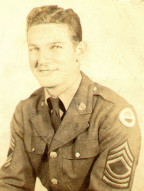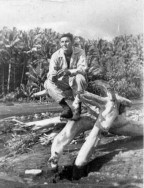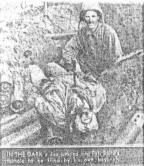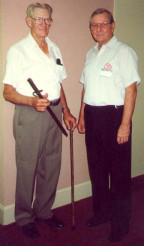124TH INFANTRY
REGIMENT
WORLD WAR II
124TH INFANTRY REGIMENT
WORLD WAR II
By M/Sgt (Aubrey) Paul
Tillery, USA
Service Company - 27 Feb. 1941 to 27 Dec. 1945
Written in 1998
Contents:
Introduction
*** Drafted
*** Basic
Training
** *Pearl
Harbor
***The
Islands
Battle
at the Driniumor River, Aitape, New Guinea
***Passing
Thoughts
***Morotai
(page 2)
***Passing
Thoughts (page 2)
***Mindanao
(page 2)
***Post
War Thoughts (page 2)

31st Infantry
(Dixie) Division shoulder patch

124th Infantry
Regiment Insignia
Service Company - 27 Feb. 1941 to 27 Dec. 1945
Written in 1998
| Contents: Introduction *** Drafted *** Basic Training ** *Pearl Harbor ***The Islands Battle at the Driniumor River, Aitape, New Guinea ***Passing Thoughts ***Morotai (page 2) ***Passing Thoughts (page 2) ***Mindanao (page 2) ***Post War Thoughts (page 2) |
 31st Infantry (Dixie) Division shoulder patch  124th Infantry Regiment Insignia |
INTRODUCTION
On September 1, 1939 the German armies overran Poland and this is generally considered the beginning of World War II. Here in the United States we accept December 7, 1941, when the Japanese launched their sneak attack on Pearl Harbor, as our entry into the War. In between these dates, Germany along with Italy, conquered most of Europe. With their backs to the wall, the British were fighting for their very lives against German bombers who were attempting to bomb them into surrender. Here at home our national leaders recognized the weakness in our Armed Forces which brought forth efforts to strengthen all military branches. Manpower was needed and the first peace time draft in our nations history was ordered. Registration day for all men (from 21 to perhaps 28 years of age) was 16 October 1940, and being 21, I registered at:Pahokee, Florida on that date. A national lottery was held to determine the order in which men would be drafted into the military service. Being "lucky" enough to draw a low number I was in the first sizable group called. My induction was at Camp Blanding, Florida and into the Army on 27 February 1941.Enlistments were for one year of military training but after the attack on Pearl Harbor we were all in for the duration of the War plus six months.
After induction I was assigned to E Company 124th Infantry Regiment, 31st Infantry (Dixie) Division. The 124th was a Florida National Guard Regiment which had been called into active service 25 November 1940, along with all the nations other Guard units. They remained in their home towns for several weeks while construction at Camp Blanding continued. During this period of time, many of the local youths faced with fulfilling their military obligation, decided to join their friends and neighbors in the National Guard. On arrival at Camp Blanding they found their new home to be a wooden floor, covered with a tent and a pot-bellied stove in the middle, all of this accommodating six men. At one end of the Company Street was the Mess Hall and at the other the Latrine. Some work had to be finished up by these guys like building boardwalks along Company Streets.
In addition it was now time to begin 13 weeks of basic training for the recent recruits Those of us who came in a little later found ourselves five weeks behind in our training. It was ordered that we be trained separately but in the same Company with our 13 weeks being crammed into an intensive 8 weeks. This was accomplished and at that time we all joined together in one Company. During the balance of May and June we experienced more advanced Infantry training. From March through June we had lots of close order drill, hikes of 10-15-20 miles. Sometimes with light packs and at other times with full field equipment. Many days of maneuvers, participating in War Games, which seemed to be all over Camp Blanding. At other times being called out in the middle of the dark night for marches through various wooded areas. It seemed to me that we were at times hiking in our sleep. Of course there was the rifle range with the 1903 Springfield, as we had not as yet received the M- 1. The Springfield was a bolt action which, in my opinion was more accurate than the M-1 but it also had a more powerful kick. At other times we were schooled in map reading, compass use, bayonet training, field hygiene and possibly other things which at the moment escape my mind.
We were now ready for a 120 mile hike with full field equipment. Marching 20 miles a day for 3 days and bivouacking in the Ocala National Forest. Next was into Ocala (I believe July 4th) and a parade. Back to the forest and maneuvers, then 20 miles per day on the return hike to Camp Blanding. We were certainly in excellent physical condition as several of us went to a dance that night, I must mention that the entire Division was in on this hike.
During the months of August and September 1941, we participated in Louisiana maneuvers. We moved from Camp Blanding to Louisiana by train and after that it was walk, walk and walk some more. I am convinced that we walked from Lake Charles to Shreveport at one time, in just 2 or 3 days. The weather, I believe, was even hotter than the hike to Ocala. These 60 days were spent sleeping on the ground in a pup tent. Once we got in on the tail end of a hurricane from which we received plenty of rain. My partner and I had our pup tent well situated and staked good, with an excellent trench and dirt piled around the edges. This got us through the storm high and dry but most of the others had every bit of their gear soaked. One highlight for us was a week-end pass to New Orleans for a little R&R. A special train picked us up and brought us back. We then returned to Camp Blanding and remained there for the rest of October.
In order that one may better understand these hikes and the physical condition required to complete them, let me explain full field equipment. This consisted of the back pack, cartridge belt, gas mask, rifle, bayonet, shelter half, blanket, poncho, shovel, mess kit and canteen. This is all that I can think of at the moment but I think you get the idea that this was not a picnic. My memory is that all of this weighed about 50 pounds. Of course that was at the beginning of a 20 mile hike. For some strange reason as the miles passed this equipment became heavier and heavier. Then on top of all that the rain or sweat made those back straps very uncomfortable and that's an understatement.
In October I was transferred from E Company to Service Company and assigned to the transportation (motor pool) platoon. The duties of this platoon was the operation, maintenance and overseeing of all the vehicles in the Regiment. My initial Job was Motor Pool Clerk and best of all no more hikes. While in the field I rode in a command car with the Regimental Motor Officer a Lt Parker, I believe from St. Augustine. Also there was the driver, Joe Lattuca, from Pennsylvania and the Regimental Motor Sergeant, Peter J. Menten from St. Augustine.
I suppose the brass figured we had enough of the summer heat so off we go for the month of November to take part in the Carolina maneuvers. This time I rode in the command car while our trucks were hauling troops and supplies. To this South Florida guy the Carolinas were really cold but you learn to cope rather quickly. I found that a poncho, blanket and the ground let you sleep quite warm. Much of the time I was in the command car as the Motor Officer went all over the place, tending to his duties. Once in this mock war, our side had been withdrawing all day. We also had been informed that the tanks had priority on the roads and we were to keep our vehicles out of their way. Late in the afternoon or early evening we stopped at a gas station or country store. While there General Patton came up and Lt... Parker ( a very brash sort of guy) went over to talk with him. The General already had a tough reputation and I thought - oh man Lt.. Parker is asking for much trouble. Anyway he approached in the proper military manner and inquired as to why our side was withdrawing as we usually don't do that. To my utter surprise the General took the time to explain that we were holding on the flanks and that the opposing force was moving into a trap. The reason the tanks had priority on the roads is that they were moving into position to spring the trap the next morning. I guess it worked as mid-morning the next day the mock battle was over.
Our vehicles in those days were not what they later became. But in spite of their sad condition we moved all of the 124th's vehicles both ways without a break down. We were the only Regiment to do so and it was recognized as a stellar achievement.
All this training and physical conditioning seemed to be worthless at the time. However let me hasten to say that in my opinion it enabled me to, withstand the rigors of combat in the Southwest Pacific. I saw lots of guys who only had their basic training and were shipped out and had a difficult if not impossible time of dealing with the hardships one experienced in the jungle. Then even worse when they had to face up to a Jap soldier shooting at him.
Our very first week-end back at Camp Blanding the Japs attacked Pearl Harbor 7 December 1941. 1 was away from camp on a week-end pass when I learned of the attack. We turned on the car radio and heard various units calling for their soldiers to return to camp immediately. We were expecting at any moment to hear the 124th calling for us to return to camp but the call didn't come. When we arrived back at camp late that night other units had already moved out. They were strung along the coast of Florida and Georgia with the mission of defending our borders against infiltration or whatever. The 124th was not called out as we had already been selected as demonstration troops at the Infantry School in Fort Benning, Georgia.
This move was completed in early January 1942 and we remained there until the Fall of 1943. While there I received promotions up to Master Sergeant which rank I held for the balance of my military service. At that time there were only 5 M/Sgts in an Infantry Regiment (about 3 500 men). Each was chief of a section. Mine being Transportation, the other 4 were Supply, Operations, Records and Communications.
Our activities called for us to put on demonstrations of various Infantry tactics as well as supply. In addition to a few demonstrations we in Service Company put on, our trucks were dispatched for the purpose of hauling troops and supplies. Among Service Company demonstrations were moving a Jeep across a deep stream by stringing cables from trees. Another was one man righting a truck that had turned over on it's side. He accomplished this alone by the use of block and tackle. There were other demonstrations from Service Company and many more from the Regiment. The most memorable one was B-188, an Infantry battalion in attack. The Battalion was capturing a hill with supporting units and all using live ammunition. It began with the bombing of the hill from the air. Then as the Officers and OCS groups sat in the viewing stands, live Artillery was fired over their heads and into the hill. Very few if any had ever heard Artillery screaming over their heads before. I feel quite certain that later on in combat they came to appreciate this sound. Next came the tanks moving on each side and Infantry ground troops in the middle moving on the hill, with all firing live ammunition. Tracer bullets were used which made it easier to follow the action from the viewing stands. It was quite an impressive sight which the viewers would probably remember for a long time.
While at Fort Benning many of the men from the 124th went out on Cadres forming the nucleus of new Infantry Regiments. If other Regiments sent out as many Cadres as the 124th, I can readily see that the National Guard became the backbone of the Infantry during World War II. While we were sending men out we were receiving replacements all the time. The majority of these had just received their basic training. The end result of all of this was that very few of the original 124th Soldiers were still in the Regiment.
Leaving Fort Benning we went to Fort Jackson, South Carolina. While there we went through some training and rifle range firing. The Regiment was deactivated, all men shipped out to other units, I went to Camp Pickett, Virginia and a return to the 31st Division, 154th Infantry Regiment. I don't recall very much activity at Camp Pickett as they had already gone through amphibious as well as mountain training before I arrived. It seemed as though we were just waiting to go overseas. It was December and snowing, which was new to me, as I had never experienced much snow. In early January 1944 we moved to Camp Patrick Henry, Virginia, a Port of Embarkation near Norfolk. We were there for about a week and snow continued to fall all the time. Then on 16 January 1944 we became the first unit of the Division to sail for overseas. We were aboard the USS Cape Neddick, an American Fruit Company vessel (Banana Boat) that had been converted into a troop ship. Now we were on our way to we knew not where at that time. At some point we had been issued summer uniforms, which was confusing to us in the cold. It seemed logical that sailing from the east coast meant going to Europe. Surely not going to Europe in winter with summer uniforms but if not - where? This was a point which was much discussed aboard ship for a few days. We had a Destroyer Escort with us and one night there was a Submarine scare but nothing happened. We passed through the Panama Canal and had no further naval escort until we were near our destination. Those 37 days aboard this ship were memorable due mostly to the monotony of it all. We were served only 2 meals a day as the shipboard facilities could not accommodate any more. Many men were seasick and had dysentery, often at the same time. What a sight, with a man on the toilet, sick at both ends. Fortunately all of this by-passed me.
The only showers we had were salt water and that can certainly get old very quickly. A little horse play was in order as we crossed the equator, thereby breaking the monotony momentarily, as we were initiated into The Royal and Ancient Order of the Deep. We stripped down to our shorts and were painted all up with flour mix and coloring or whatever. Next came a run through the belt line with many getting a whack at us. I noticed that they seemed to be trying to pick on me more than the others and wondered why. I later learned that in marking us up, the NCO's and Officers were identified by rank so the Privates had the opportunity for a moment of revenge.
We sighted some islands such as the Easter Islands, Pitcairn and Bora Bora as well as others. Our ship anchored in the lagoon at Bora Bora for one night but we were not permitted off ship. It was a beautiful sight that still remains in my memory. We bought some bananas from the natives who came out to the ship in their little boats.
Finally we arrived at Goodenough Island but the rest of the Division was diverted to Oro Bay on the New Guinea mainland. We had some work while at Goodenough, assembling vehicles and sending trucks to haul cargo from the dock to dumps. Mostly though there was idle time which led to some horse play. We had live ammunition and some of the guys had been shooting parrots and possibly some of the rare birds which this area is noted for. Even after orders from headquarters to cease someone in Service Company shot a parrot. This caused quite a fuss but it was never discovered who did it. Then gasoline was used to pour a stream from the jungle to a nearby tent and encircle it. The gasoline was set fire and quickly encircled the tent. Can you imagine waking up in a strange place with people yelling fire and your tent is encircled in flame. An yet another time gasoline was dumped into a stream that flows by the Company. In the middle of the night as the gasoline was set fire the cry went out, "the rivers on fire". Very strange in a strange land.
While on Goodenough Island the Regiment was redesignated the 124th - so in reality my entire Army time was with the 124th Infantry Regiment and my only Division was the 31st Infantry (Dixie) Division. After being on the island a few weeks we shipped over to Oro Bay and joined the rest of the Division. The old ship we were on, named the West Cactus, I thought surely would sink as we were listing all the way. However we made it and some training followed in getting accustomed to the jungles and the climate as we prepared for combat.
As a soldier in the 124th Infantry Regiment, I gained some of the information that follows, from personal experience and from others in Service Company as well as the Regiment. Much was also learned from various Army publications. One book was written solely about the battle along the Driniumor River near Aitape in New Guinea. The writer of this gained some information from daily unit records. These records were not very well written as the conditions in the jungle were not suited for this type of work. He also interviewed, many years later, soldiers who were there. We did not have cameramen and historians with us and because of a lack of information the writer of this book had a most difficult task. In my opinion he did and excellent job, in spite of the sparse information available to him. In the jungle a soldier would know what was happening only where he was, while just a few yards away he would have no idea what was going on over there. Let me assure you that no one person had an overall idea of what was happening along and near the Driniumor River in New Guinea. Not even the Generals, which I'll refer to later.
The 124th participated in three campaigns which were essentially three different types of warfare. 1. New Guinea - in dense jungle and swamp along the Driniumor River in a defensive position. Plus a 10 or 11 day offensive across the River. 2. Morotai - An amphibious landing, taking only part of the island, forming a defense line and protecting the base against any enemy ground attack. 3. Mndanao, Philippines - Advancing along a dirt road through jungle and mountains in an offensive battle.
It is my intent to convey to the reader the extremely difficult conditions under which my Regiment (124th Infantry) operated in the above campaigns. The Foot Soldiers in the Southwest Pacific, without a doubt, fought in the worst conditions of any soldiers in any part of the world during W.W.II. I read somewhere that it required (I believe 7) soldiers to supply 1 Foot Soldier in the Southwest Pacific. My job in transportation was a part of this supply group. Thus this is a little about me and a lot about the 124th Infantry Regiment and it's Foot Soldiers. It is now time for our first combat.






